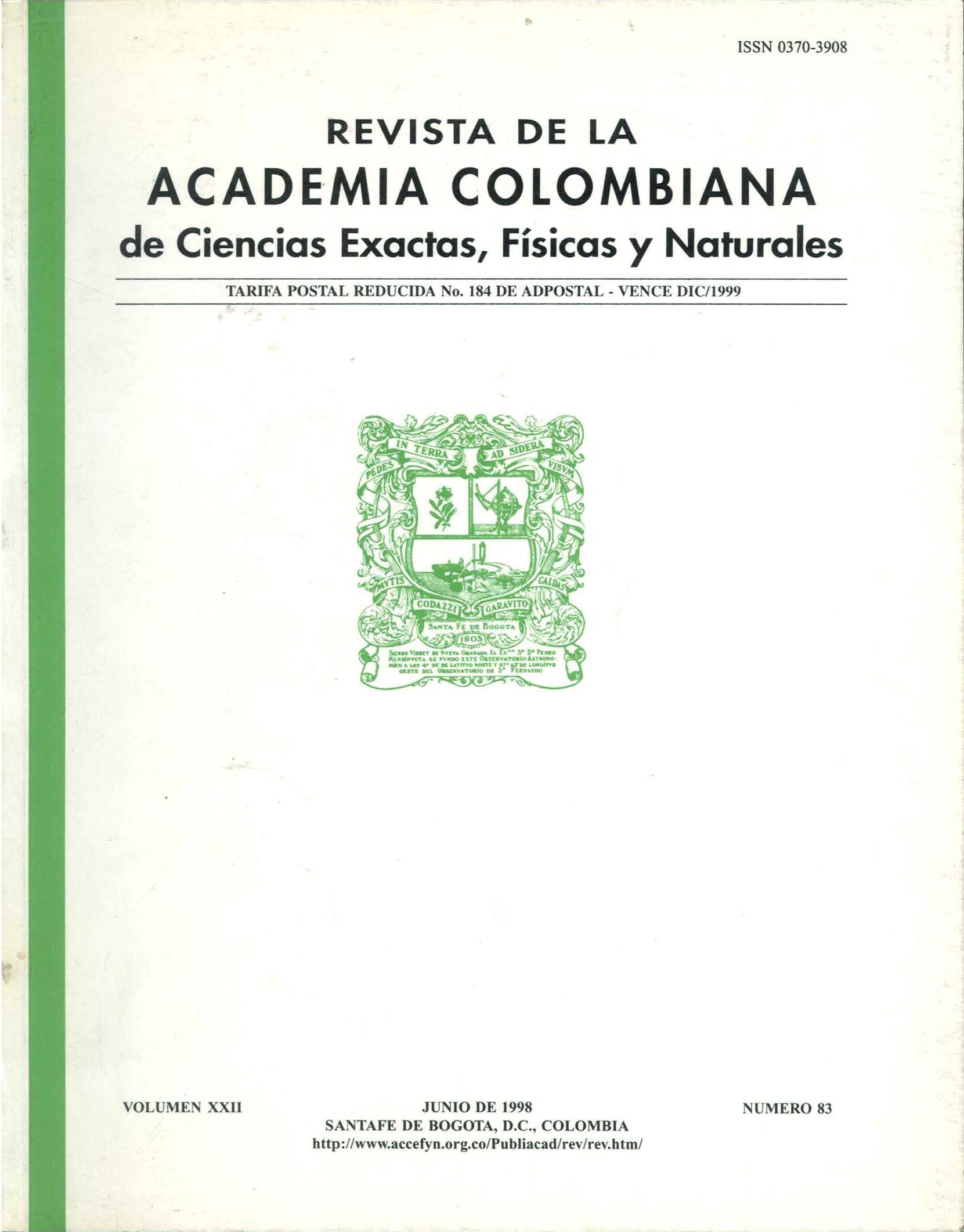Resumen
Los hongos entomopatógenos (EPF) han sido ampliamente utilizados en el control biológico de plagas, tanto individualmente como en forma integrada (1PM). Tal manejo ha causado un impacto agrícola en beneficio de los cultivos. Los hongos entomopatógenos pueden jugar un papel significativo en la preservación y en el balance natural de la biota útil, así como en su expansión activa, como ocurre en el bosque húmedo tropical, en la selva andina y en otros ecosistemas agrícolas de Centro y Suramérica. De todos los EPFs conocidos, cerca de media docena cumplen con los requisitos para ser utilizados industrialmente en biotecnología de tipo R y D. Latinoamérica ejerce un liderazgo en el uso de EPF en 1PM en las prácticas agrícolas y en el diseño racional de bioinsecticidas. Para mayores beneficios, deben aumentarse tanto la investigación como los esfuerzos por industrializar los EPF en el manejo integrado de plagas, dado que su potencial como micoinsecticidas está en pleno auge y desarrollo.
Referencias
Altieri, M. A. 1994. Biodiversity and pest management in agroecosystems. Ford Products Press, an Imprint of The Haworth Press Inc., New York, NY, USA. 185 pp.
Andrews, K. L. and Quezada, J. R. 1989. Manejo integrado de plagas insectiles en la agricultura: estado actual y futuro. Departamento de Protección Vegetal. Escuela Agrícola Panamericana, El Zamorano, Honduras, Centroamérica. pp. 623.
Burgerjon, A. and Dulmage, H. 1977. Industrial and international standardization of microbial pesticides. 1. Bacillus thuringiensis. Entomophaga 22: 121-129.
Cardona, C. 1995. Entomología y control de plagas: análisis y perspectivas para el futuro. MIP: manejo integrado de plagas en cultivos y medio ambiente. Capítulo 1. Ciencia y técnica para el MIP en cultivos 1: 1-6.
Feinsilber, J. M. 1995. Cuban Biotechnology: The strategic success and commercial limits of a first world approach to development. Chapter 5. In Biotechnology in Latin America: Politics, Impacts and Risks. Peritore, N. P. and Galve-Peritore, A. K. (Eds.). pp. 97-126. Scholarly Resources Inc. Wilmington, DE, USA.
García, F. 1995. Control Biológico de plagas del algodonero en el Valle del Cauca. MIP: manejo integrado de plagas en cultivos y medio ambiente. Capítulo 3: implementación del MIP en Colombia en diferentes cultivos. pp. 71-72.
Glare, T. R., Milner, R. J., Chilvers, G. A., Mahon, R. J. and Brown, W. V. 1987. Taxonomic implications of intraspecific variation amongst isolates of the aphid-pathogen fungi Zoophthora radicans Brefeld and Zoophthora phalloides Batko (Zygomycetes: Entomophthoraceae). Australian Journal of Botany 35: 49-67.
Hegedus, D. D. and Khachatourians, G. G. 1994. Isolation and characterization of conditional lethal mutants of Beauveria bassiana. Canadian Journal of Microbiology 40: 766-776.
Hegedus, D. D. and Khachatourians, G. G. 1995. The impact of biotechnology on hyphomycetous fungal insect biocontrol agents. Biotechnology Advances 13: 445-490.
Khachatourians, G. G. 1986. Production and use of biological pest control agents. Trends in Biotechnology 4: 120-124.
Khachatourians, G. G. 1996. Biochemistry and Molecular Biology of Entomopathogenic fungi. The Mycota VI: Human and Animal Relationships. Howard, D. and Miller, J. D. (Eds.). Springer-Verlag. Berlin Heidelberg. pp. 331-363.
Khachatourians, G. G. 1991. Physiology and genetics of entomopathogenic fungi. In: Arora, D. K., Ajello, L., and Mukerji, K. G. (Eds.). Handbook of Applied Mycology. vol. 2: Humans, animals and insects. Marcel Dekker, New York, pp. 613-661.
Morales, E. 1995. Propuesta de Proyecto Marco Agrobiológicos. Publicación Interna, Hoechst-Schering Agro, AgrEvo S.A. Santafé de Bogotá, Colombia. pp. 30.
Murillo, A. and Cifuentes, F. 1997. Una propuesta de modelo MIP en algodón. MIP: manejo integrado de plagas en cultivos y medio ambiente. Capítulo 3: Implementación del MIP en Colombia en diferentes cultivos. pp. 66-70.
Nene, Y. L. 1996. Sustainable agriculture: future hope for developing countries. Canadian Journal of Plant Pathology 18: 133-140.
Peritore, N. P. and Galve-Peritore, A. K. 1995. Biotechnology in Latin America: Politics, Impacts and Risks. Scholarly Resources Inc. Wilmington, DE, USA. 229 pp.
Rodríguez del Bosque, L. A. 1994. Teoría y bases ecológicas del control biológico. V congreso y curso de control biológico de plagas. Memorias. Instituto Tecnológico Agropecuario, Oaxaca, México. pp. 6-19.
Rodríguez-Rueda, D. and Fargues, J. 1983. Pathogenicity of entomopathogenic hyphomycetes, Paecilomyces fumosoroseus and Nomuraea rileyi to eggs of noctuids Mamestra brassicae and Spodoptera littoralis. Journal of Invertebrate Pathology 34: 399-408.
Ruttan, V. W. 1996. Research to achieve sustainable growth in agricultural production: into the 21st century. Canadian Journal of Plant Pathology 18: 123-132.
Sitch, J. C. and Jackson, C. W. 1997. Pre-penetration events affecting host specificity of Verticillium lecanii. Mycological Research 101: 535-541.
Smith, R. F. 1974. The origins of integrated pest control in California: an account of the contributions of Charles W. Woodworth. Pan Pacific Entomologist 50: 426-440.
Trumble, J. T., Carson, W. G. and Kund, G. S. 1997. Economics and environmental impact of a sustainable Integrated Pest Management program in celery. Journal of Economic Entomology 90: 136-146.
Valencia, E. and Khachatourians, G. G. 1998. Integrated pest management and entomopathogenic fungal biotechnology in the Latin Americas. II. Key Research and Development Prerequisites. Submitted to: Revista de la Academia Colombiana de Ciencias Exactas, Físicas y Naturales.
Valencia, P. E. 1993. Posibles modelos para el manejo integrado de la broca. Agricultura de las Américas 217: 20-22.
Valencia, P. E. 1994. Modelos para el manejo integrado de la broca del café. Agricultura de las Américas 218: 26-28.
Valencia, E. 1993. Resistencia enzimática a insecticidas en larvas de Heliothis virescens (Lepidoptera: Noctuidae). Revista Colombiana de Entomología 19: 131-138.
Valencia, P. E. 1995. El manejo integrado de plagas (MIP) y la regulación biológica: verdaderas alternativas para el desarrollo agrícola sostenible. MIP: manejo integrado de plagas en cultivos y medio ambiente. Capítulo 1: ciencia y técnica para el MIP en cultivos 1: 57-60.
Valencia, P. E. 1995. Manejo integrado de plagas (MIP): alternativa para el desarrollo agrícola sostenible. Agricultura de las Américas 233: 19-21.
Wright, J. E. 1993. Control of the boll weevil (Coleoptera: Curculionidae) with Naturalis-L, a mycoinsecticide. Journal of Economic Entomology 86: 1355-1358.

Esta obra está bajo una licencia internacional Creative Commons Atribución-NoComercial-SinDerivadas 4.0.

